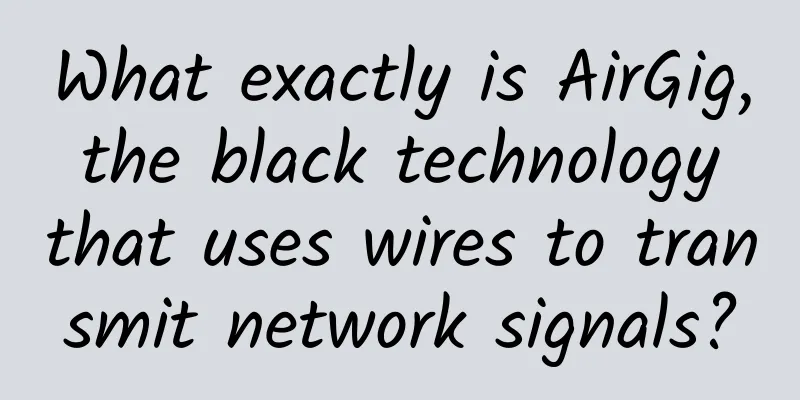What exactly is AirGig, the black technology that uses wires to transmit network signals?

|
At the MWC 2017 conference, which has ended, people discussed 5G, the successor to 4G. It stands to reason that 5G can certainly bring a better network experience than 4G, but the problem is that it does not exist as an industry technical standard. No one knows what 5G is, let alone how to achieve it and when it will arrive. That is why AT&T engineers have proposed another technology that aims to bring faster broadband, stronger signal quality, and even to areas where the network is underdeveloped. What is AirGig? AirGig can support ultra-fast Wi-Fi almost everywhere without the need for dedicated lines or signal stations. So, what exactly is AirGig? There is a saying that AirGig is a "power line broadband" technology, abbreviated as PBL, because its network signal transmission depends on power lines. However, according to the latest public information, the actual situation is not the case, because in the technical description of AirGig, the signal is not transmitted directly through the power line, the latter is only responsible for guiding it. AT&T chose to place an ultra-lightweight wireless network device on the top of the pole, and then the wireless signal will travel along the power line to form a connection and communication between each other. Because the popularization of electricity has a long history, it is much wider than the popularization of the Internet. Therefore, with AirGig's power-guided transmission technology, we can popularize ultra-high-speed wireless networks almost everywhere. If this vision can be realized, it will undoubtedly be another innovation. But in fact, in terms of the principle concept, AirGig's technology is not yet a "black technology" because it has been proposed a long time ago, and there is no high technical difficulty. It's just that with the development of the times, the speed of wireless networks has been fast enough for engineers to consider this application. The previous technical deficiencies were millimeter wave technology and extremely high frequency technology. The latter is considered to be an ideal choice for long-distance point-to-point high-speed wireless networks, while the former has a shorter distance and is mainly used to deploy high-speed networks around utility poles and cable towers. The most interesting thing about AirGig technology is that its cost can be very low, because the wireless equipment on the top of the utility pole can be made of plastic, which is relatively cheap. Most importantly, there is no need for an electrical connection between this device and the utility pole, because the former can directly use the magnetic field around the latter to generate electricity through inductive coupling to provide itself with electricity. In this way, the cost of deploying AirGig is even lower because you don't need to make more modifications. Necessity of AirGig According to AT&T’s survey data, the amount of data on its deployed networks has soared by 250,000% since 2007, and the popularity of the online video industry has accelerated the increase in demand. Even without mentioning those emerging developing countries, even in the suburbs of the United States, the problem of slow Internet speed or even no Internet is very common. One of the important reasons why AT&T went in the direction of AirGig is that it is easy to deploy - after all, you can make do without the Internet, but it is terrible without electricity. But no matter what, fiber optic network is still a very popular and widely recognized gold standard accepted by all consumers, and it still has potential in the future. Fiber optic network has been deployed so widely, why do we still need AirGig? What reason does it really have for people to give up the standard they are used to? As we said above, the answer to the question is still "money". Although fiber optic network can theoretically reach quite terrifying speeds, the cost issue cannot be ignored, not to mention that you need to wire, amplify the signal, and bring all of these to every home. Because of this, compared to electricity, the network is deployed more densely in more prosperous areas. If there is AirGig, it is equivalent to a cheaper and more affordable deployment solution for high-speed networks. As for the network speed, AirGig's performance itself is not bad, but as a technology that is recently planned to be applied, its speed performance is certainly not as good as traditional solutions. In fact, some telecom operators said that they have achieved a network experience of 20Gbps and less than 1 millisecond latency in the laboratory. So some people also think that AirGig may be more of a transitional technology. AT&T has said that the company always puts ultra-high-speed network implementation first, whether it is wired technology or wireless technology. In this regard, AirGig may be a little powerless compared to traditional fiber solutions. However, AT&T still has confidence in this technology. It believes that AirGig can be used in future 5G network services. The prospects of AirGig In recent years, AT&T has been conducting BPL technology outdoors for a long time, but it was not until February this year that it revealed that it would have further discussions with power companies on the issue of AirGig trials. Before the end of 2017, AT&T will conduct pilots in two regions, one of which is the United States and the other is not. Considering that AirGig technology is mainly easy to deploy and low-cost, AT&T may have the ambition to promote it to the world. According to information previously revealed by AT&T executives, the company will cooperate with a large number of power companies and public utility companies to persuade them to agree to AT&T to use its power network. With such a huge momentum, we are also expected to be able to really see the actual application of AirGig. However, this does not mean that we will see the advent of AirGig soon, because according to the results of the discussion at the MWC 2017 conference, 5G networks will be possible to achieve at least in 2020. Even by that time, AirGig technology may not be able to reach the speed of 5G level, and even the way it is promoted to consumers may be different from 5G. Therefore, AirGig technology will not make us feel the surge in network speed. Its advantage is low cost and easy deployment. Of course, its realization is definitely a good thing. In the future, we may even be able to enjoy wireless network services in a wider area. However, AT&T also admitted that the technology is still in the experimental stage, so we will have to wait. As a winner of Toutiao's Qingyun Plan and Baijiahao's Bai+ Plan, the 2019 Baidu Digital Author of the Year, the Baijiahao's Most Popular Author in the Technology Field, the 2019 Sogou Technology and Culture Author, and the 2021 Baijiahao Quarterly Influential Creator, he has won many awards, including the 2013 Sohu Best Industry Media Person, the 2015 China New Media Entrepreneurship Competition Beijing Third Place, the 2015 Guangmang Experience Award, the 2015 China New Media Entrepreneurship Competition Finals Third Place, and the 2018 Baidu Dynamic Annual Powerful Celebrity. |
<<: NVIDIA's road to mobile chips: Smartphones failed, smart cars rose
>>: Xiaomi Surge S1 processor performance test: Can it beat Snapdragon 625?
Recommend
Kuaishou operation creates a "fast brand" from 0 to 1!
At the beginning of 2022, I became a Kuaishou e-c...
Why do we sleep? Massachusetts General Hospital discovers the first replay phenomenon in the human brain's motor cortex
"This is the most direct evidence yet of rep...
Has Su Dongpo, who “ate 300 lychees a day”, ever eaten Sichuan lychees?
As we all know, the great writer Su Dongpo was a ...
2019 Fliggy 3rd Anniversary Event Planning and Promotion Plan!
This article mainly wants to share with you my pe...
Spring Festival travel rush in progress | What can the security staff see when you go through security check? What should you do if there is radiation?
Audit expert: Meng Meng Associate Researcher, Ins...
Is anesthetic a medicine or a poison? Uncovering the secret of "propofol" abused in the entertainment industry!
Propofol is a commonly used anesthetic, often use...
Realme Q3 review: unrivaled performance in its class, a model of the best smartphones under 1,000 yuan
What is the most difficult thing for a painter to...
Zi'an Real Estate Financial Quotient Leasing Practice Training Camp (Third Session) Course
You must be familiar with the IP Zi'an. He in...
"Twenty-four, sweep the house"! Dust and cloth, don't miss these corners →
The Spring Festival is approaching, and every hou...
When will Alipay collect blessings in 2020? Mutual assistance and strategies for collecting blessings cards in 2020!
In recent years, in addition to the traditional w...
Does dating make you fat? Does “love brain” make you less intelligent? Are these true?
The most vicious curse for a young person, beside...
The TV industry is moving towards segmentation: games become the biggest active variable
Since the development of China's television in...
Can eating dark chocolate help you lose weight? Why not do these 4 things!
Author: Xue Qingxin, registered dietitian Reviewe...









